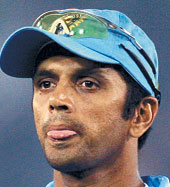 |
It was 1998 and a very young and tense member of the Indian cricket team feared the worst for his career. So worried was he that he approached a sports psychologist at his residence in Dadar, Mumbai, to make a last-ditch attempt at saving his sinking ship.
After four-and-a-half hours of discussing focus, confidence, approach and playing style, Rahul Dravid — the cricketer in question — seemed all ready to battle fear. “I saw a world class player in him even then,” says the psychologist, B.P. Bam — a retired Inspector General of Police (Maharashtra) who has helped put the spunk back into the game of sport stars such as Sachin Tendulkar and billiards champion Geet Sethi.
But two World Cups later, and on the cusp of the third, the Indore-born Bangalorean seems shaky once again. Rahul Sharad Dravid may be steering the skipper’s wheel on a ship he was almost certain of being laid off from, but he is in troubled waters. And this, despite his own enviable average and India’s victory over Sri Lanka in the ODI series.
The unexpected happened on Wednesday last week when Dravid suddenly snapped at a press conference when asked to comment on a leaked report by Chetan Desai, the manager of the Indian team on the tour of South Africa, that spoke of a clash between coach Greg Chappell and Virender Sehwag ahead of the Durban Test. “I’m being asked questions and being asked my views on a report given by someone who, when I last looked at the history of Indian cricket, I didn’t necessarily see his name featuring very prominently,” he said, rather uncharacteristically, about Desai.
It seems just the other day that Dravid was everybody’s idea of a dream captain. He led a group of young men who whistled their way from one victory to another. But things are no longer the same. Despite the occasional victory, critics hold that he often seems to be taking the wrong decisions during a match. The old allegation — that he lacks the killer instinct — is surfacing again.
To top it, injuries are mounting — rendering Ajit Agarkar, Irfan Pathan, Yuvraj Singh and, now, Tendulkar — often unfit for matches. “Dravid is, indeed, a worried man,” says Bam, who continues to play philosopher and guide. “There are twice as many injuries in the team since the 1980s — a clear sign of players being highly stressed,” says cricket historian Boria Mazumdar.
No wonder Mr Unflappable looks shaky. “Dravid’s reserved nature is coming in the way of his team’s performance,” says former chairman of the National Cricket Selection Committee Ajit Wadekar. “He needs to be more communicative and take his team into confidence on the field,” he adds.
Clearly, the nice guy image isn’t working anymore. “A leader needs to have knowledge and a killer instinct. He needs to be ruthless, not a diplomat, at least not in the sports arena,” says Shailendra Singh, managing director, Percept D’Mark, a brand management company based in Mumbai. “Dravid is a nice guy, but nice guys don’t like controversies. He is also a yes man. We need a more confident captain for the World Cup. The board certainly needs to groom the next captain.”
There is a perceptible lack of enthusiasm on the field, and Dravid, as the captain, is, not unsurprisingly, getting the flak for it. Old-time cricketer and former chairman, National Cricket Selection Committee, Chandu Borde, is perturbed by the clear loss of fervour. “But I suppose one does get tired of eating the same food every day. It (playing matches) has become a daily routine. It has become like going to work every day.”
Stress, many believe, is a reason Dravid is not at his best, despite an excellent knock every now and then. And stress, holds clinical psychologist Varkha Chulani, is all pervasive. Chulani who has been seeing an average of four “distressed” cricketers a year over the last five years since she has been associated with Team India, says that most of the men who consult her are “depressed and disillusioned” and in the 25-32 age group.
While Chulani refuses to mention any names, she points out that most of the cricketers she meets are “sensitive” men. “A thick-skinned person would never walk into my door. A Sehwag would never come, while a Dravid would.”
Some believe that Dravid is not the problem — it’s the team that is wanting. “A cricketer is as good as his team,” says former captain Nari Contractor. “If Ricky Ponting is made captain of the Bangladeshi cricket team, will it win?”
Chulani, for one, sees envy and malice among team members — emotions that do not speak well for Dravid’s captaincy. “On reading between the lines, I get a strong and repeated feeling that players are settling scores on field through sabotage, say, by dropping a catch to deprive a certain bowler of wickets.” At the bottom of this, she emphasises, lie feelings of jealousy, grudges, one-upmanship and passive aggression.
But then, as Percept D’Mark’s Singh says, “If a captain is given a weak team, he has to voice it. As the captain of the Indian cricket team, he has to realise that he is sitting on a hot seat — which represents money and emotions.” Or, as former cricketer Dilip Sardesai puts it, it is up to a captain to bring about changes. “Captains today, unlike in the Sixties and Seventies when selectors called the shots, have a lot of power. Nowadays, the team is picked by the captain and the coach.”
To an extent, many believe that Dravid has begun to make his voice heard. “He is more assertive, also because he realises that he is the one who will be blamed if things go wrong,” says Wadekar. Some, like commentator Harsha Bhogle, even believe that in a game where aggression has come to be paramount, Dravid, in his own quiet way, has been making a mark. “He chose to play with five bowlers as often as he could and puts pressure on his batsmen to perform,” says Bhogle. “Dravid has even begun showing his temper and gesturing on field,” he adds.
Most people would still call Dravid a cool customer — or a type B personality, as Mumbai-based Dilip Nadkarni, an orthopedic surgeon specialising in sports medicine, puts it. Bam, however, stresses that his serious temperament is both an advantage and a disadvantage for him. “It’s a disadvantage because he finds it difficult to put unpleasant things behind him,” he says.
There have been changes in Dravid over the years. Bam believes that he has become more adept at handling stress — something that Nadkarni endorses. Many cricketers, he says, deal with stress through partying, flirting and music — with preferences ranging from Punjabi pop to techno and Bach. Dravid, Nadkarni says, takes the more sedate routes, such as reading mostly non-cricket stuff and practising nyaas, a yogasana focusing on the 27 nerve centres of the body.
Focus, Bam holds, is something that Dravid developed through some non-yogic methods, too, such as wicket keeping, which he initially resented doing.
Clearly, not everybody is ready to write off the skipper. The Dravid that former cricketer Roger Binny knows has a long innings ahead of him. “He is down to earth and doesn’t throw his weight around in the team and mixes with the youngsters,” he says.” “One cannot ask for a better captain than Dravid,” he adds.
This, the supporters hold, is just a bad spell that Dravid will rise from. “Nowadays, he is not the same batsman that he was, he does make a lot of mistakes,” admits Sardesai. “But cricket is a funny game, with its ups and downs. A great player will finally come back.”
Bhogle seconds that. “Every player goes through phases when it seems no one can get him out and when it seems someone just needs to roll his arm over to dismiss him. The good players are those who are able to balance one wave against another,” says Bhogle.
Yet on the field, it is finally the winning of a match that spells success. You are, after all, as good as your last victory; or as bad as your last defeat.











